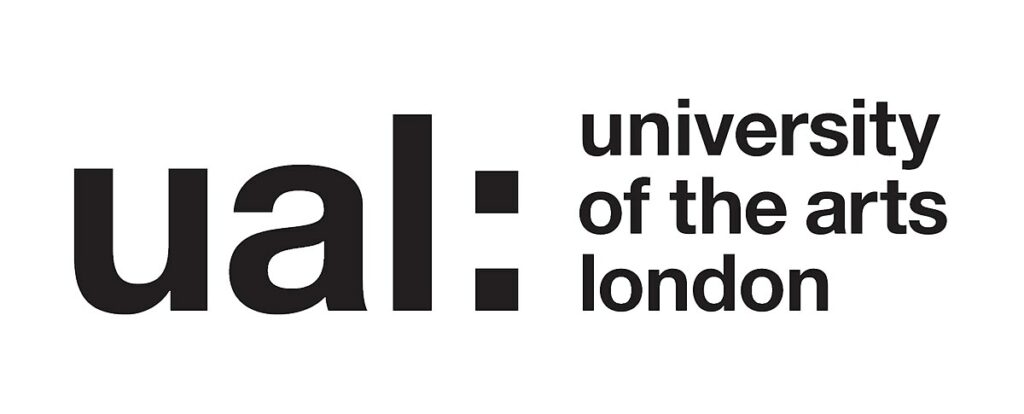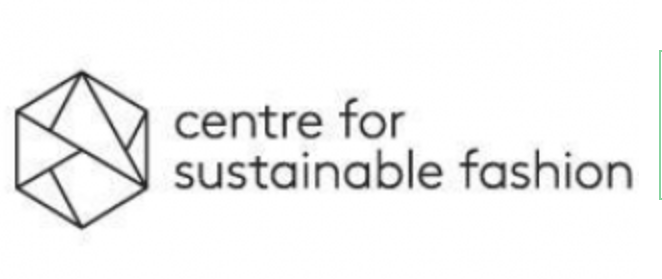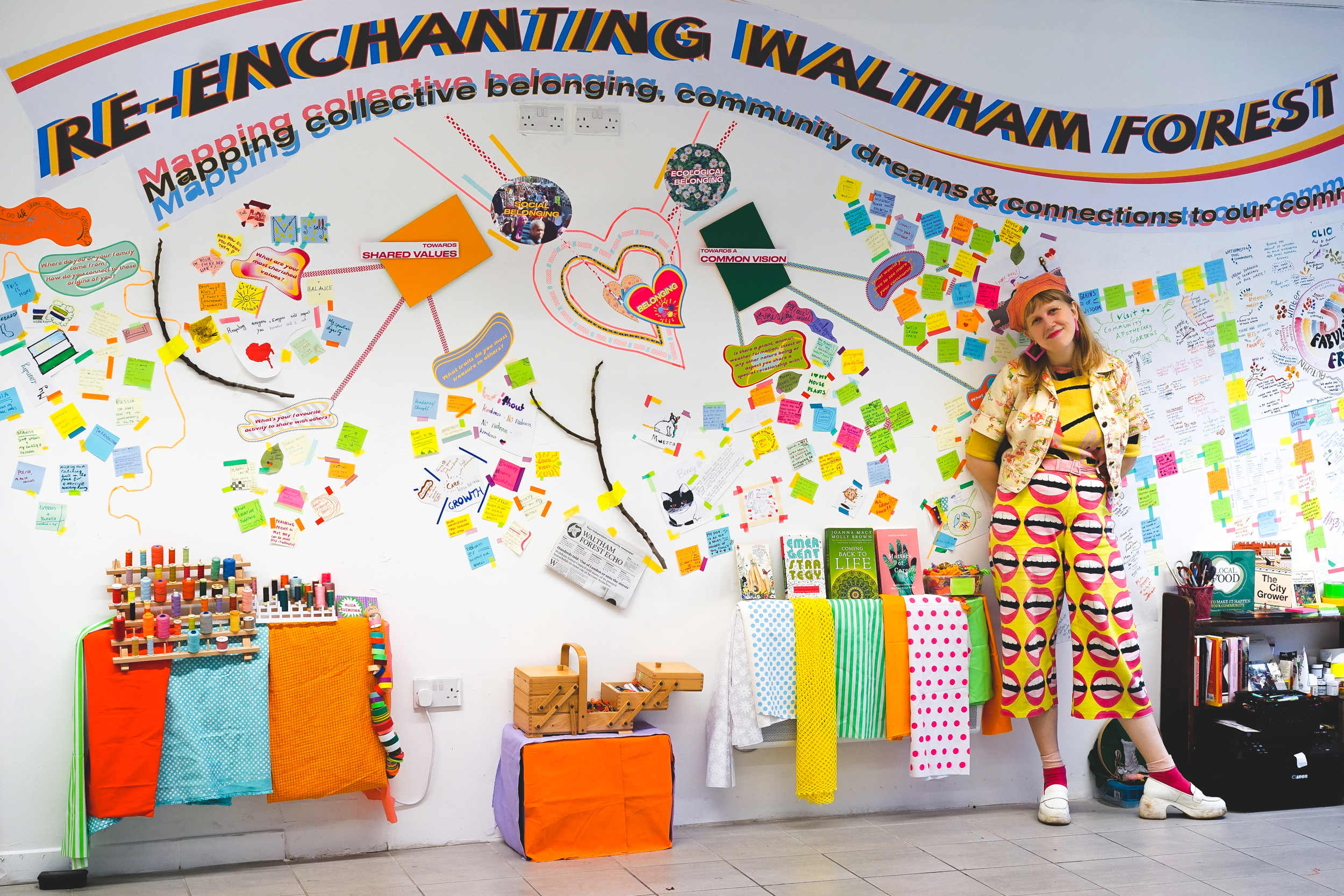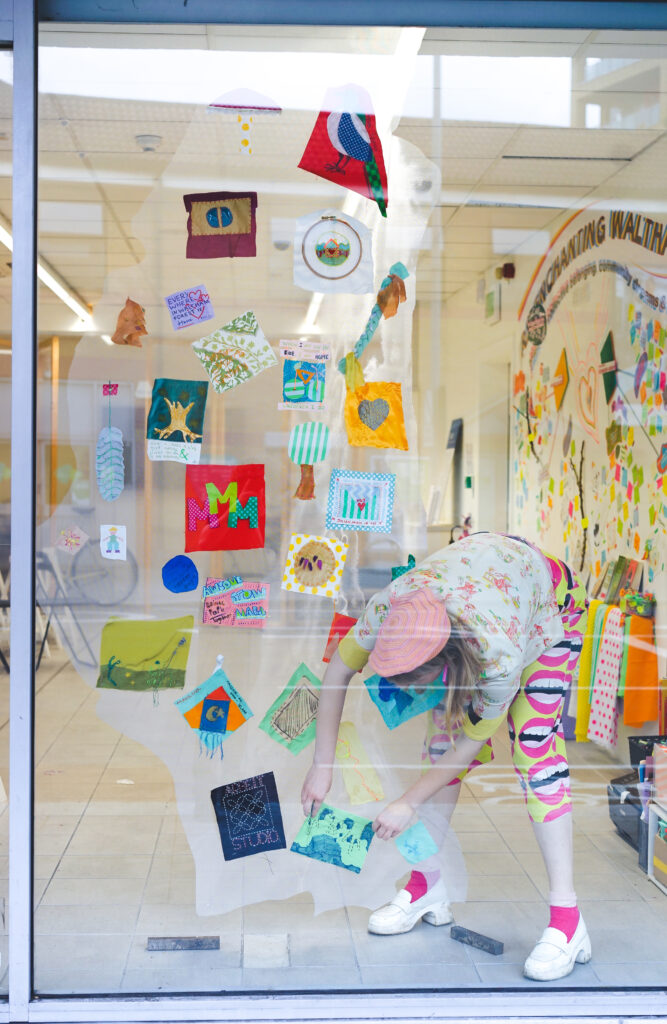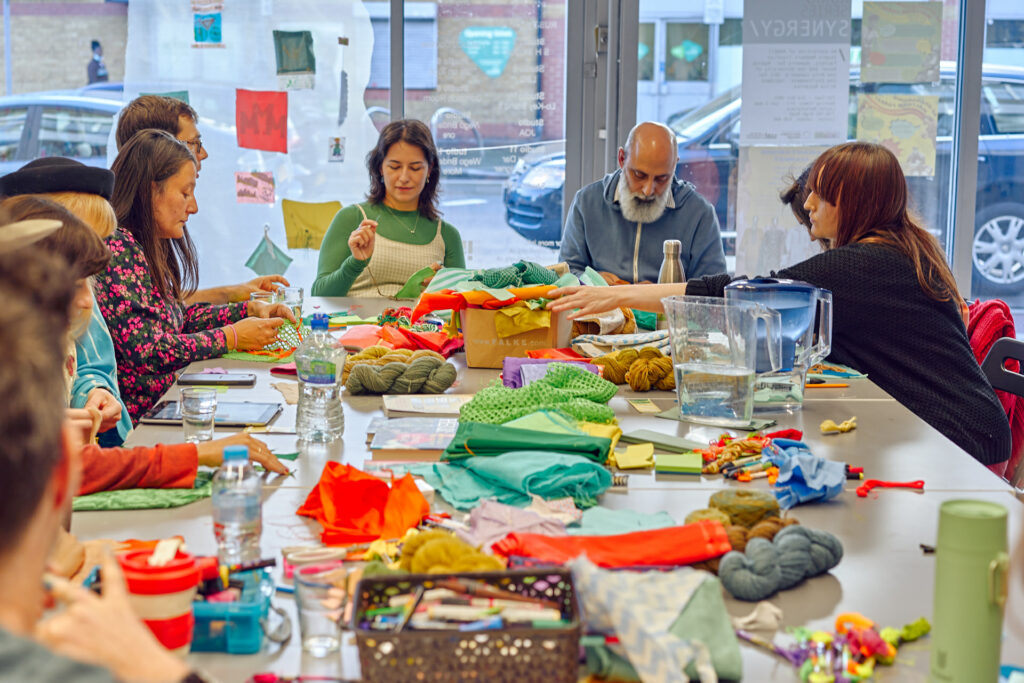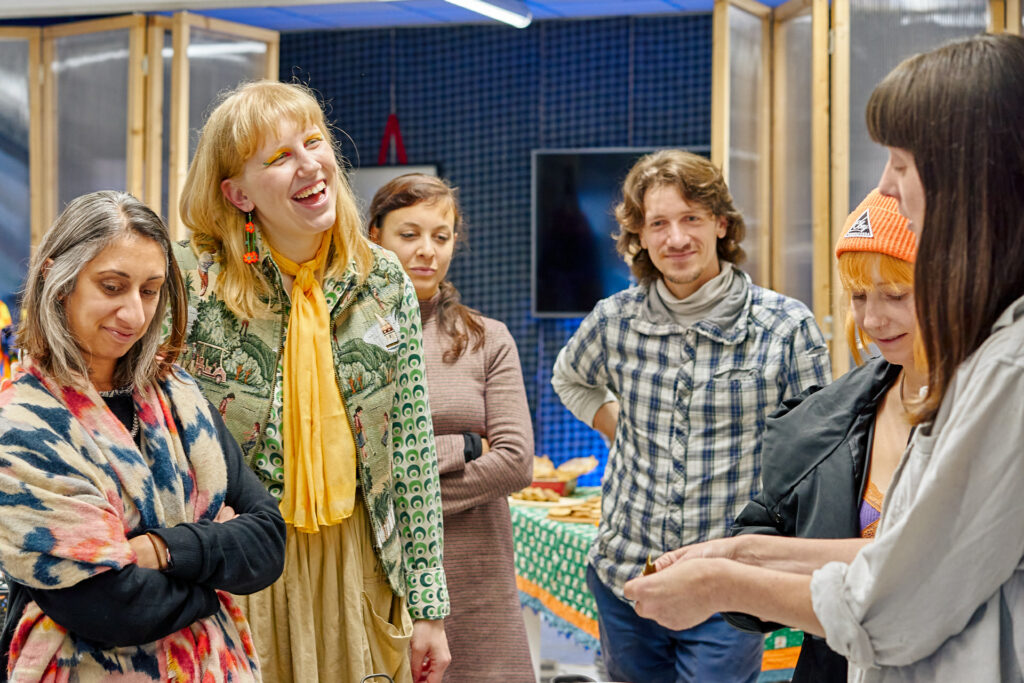RE-ENCHANTING WALTHAM FOREST
2021
Re-Enchanting Waltham Forest was a residency at Arbeit Leyton Green Studios as part of The Art for the Environment International Artist Residency Programme, set up by Professor Lucy Orta UAL Chair of Art for the Environment and Making For Change: Waltham Forest – a partnership project between Centre for Sustainable Fashion (LCF) and London Borough of Waltham Forest (LBWF).
During the residency I created a temporary civic space in the heart of Leyton where I facilitated place-specific conversations and exchanges that stimulated the emergence of community-based approaches, with the aim to expand the sense of ecological and social belonging within the local public, and to encourage more localized land-based ways of living in the urban environment. That was accomplished through community dialogue, research workshops, experiments in social dreaming, communal mapping and making processes, and building of shared knowledge resources for re-connecting to local nature, culture and community.
Read the full residency report HERE
OUTCOMES:
3 week residency
12 days of drop-in conversations with the public
38 conversations with the passers-by
4 experimental workshops / community research investigations
10 local knowledge keepers workshop collaborators
41 workshop attendees
1 participatory community artwork
1 participatory community wall of knowledge
1 exhibition
1 report
THE TEXTILE MURAL MAP OF LOCAL KINSHIP
One of the key areas of research I am interested in is how can the process of making and crafting be looked at as a form of language in its own right that creates physically tangible and trackable forms of conversation. Additionally, I am curious about how making can be a useful companion to the verbal conversations by being used as a way of processing, integrating, and sparking other more embodied ways of thinking and knowing throughout a conversation.
Using the residency ground to deepen this research, every visitor and workshop participant was invited to make a patchwork of a place in the area which makes them feel at home and that others could visit as well. While making the patch, stories would emerge. These patchworks were then placed onto a 2,5 m mural base made in the outline shape of the borough.
It was precious to see glimpses of environmental intimacy and kinship initiating during these sessions with people taking time out of their day to praise and recall their nature connections using not just their head, but also their hand and heart. Quite a few visitors got to learn how to hand-sew and use a sewing machine thanks to this patchwork invitation, with the youngest apprentice being 8, and the oldest – 68, taking this precious skill into the rest of their lives.
Local exerts that contributed to the workshop: Hannah Lamdin of Love & Labour, a local ecologist, natural dyer and forager; Rebecca Teague of Baba’s Bites, chef and illustrator; Stephane Auberval, a volunteer for a food waste-redistributing group Community Fridge of Transition Leytonstone
Fabulous & Frugal
Natural Dyeing Exploration & Culinary Feast Exploring Food Waste & Local Land’s Abundance
During the workshop we engaged with the process of natural dyeing as a container and metaphor for a more unified and tangible way to explore topics of food and fashion waste, sourcing food and dyes locally and living in tune with the land through building relationships with the local plants.
The workshop started with a meditation expanding participants’ ecological sensoria. We’ve connected to the locally inhabiting plant kingdom and brought their presence into the room to stay with us for the duration of the day. The attendees were then invited to embroider and patch their favourite plant being in Waltham Forest as an activity to drop in and out of for the duration of the workshop. In the first part of our exploration, we discussed ways in which we can live in deeper connection with the local land by exploring the ethics and joys of foraging. As part of this journey we were guided through the natural dyeing process with marigold, all meanwhile sipping on freshly foraged marigold and nettle tea and snacking on marigold-infused cookies.
In the second part of the workshop, we focused on hunting for food waste as an approach to foraging within the urban context, while also bringing in reflections on fashion industry waste and dye toxicity. To guide our conversation, we dyed with onion skins and avocados, while we feasted on onion jam, avocado and zucchini salad and other delicacies – an abundant banquet created with food waste left behind at the end of the market day on Walthamstow High Street.
The sensorial unity of ways through which we simultaneously experienced the plants – the tactile act of dyeing and stitching, the bright visuals of dyed colours and taste via the enriching flavours of the feast, along with using imagination for the meditation – created a truly holistic and wholesome plant-centred experience. The similarities of issues around fashion and food were brought together in a creative way in a space where we could reflect on the malfunctioning of the bigger systems that cause the creation of waste within both industries as well as discuss alternative ways of engaging with local resources that are more poetic, caring and prioritize relationship building.
Cultivating Eden
Conversations on Growing and Caring for Ourselves and Our Urban Green
This workshop idea came from conversations with the local resident Serdar, who shared with me his dream to create a naturopathic hospital with a garden where the community could harvest their medicine. Unknown to Serdar, this dream is already being brought to life by a group of volunteers and herbalists from Community Apothecary, just a street away from his home.
The workshop explored topics of care and growing on personal and ecological levels, highlighting this often-invisible link of interconnectedness between caring for ourselves and caring for our environment and how creativity and craft can be of assistance to that connection. We kicked off the session with a touching sharing on what was the last self-caring thing each one of us has done for ourselves, and afterwards – for the ecological world around us. After that the participants were invited to create a patchwork of the place where they feel safe and cared for by the urban nature, meanwhile sharing in small groups. Naturally dyed fabrics created at the Fabulous & Frugal workshop were incorporated into each patch.
Afterwards, we set off to visit the garden, where we delved deeper in discussion around plants, their healing powers and different global and ancient modalities and approaches to health. We shared herbal recipes for wellbeing, gardening tips and strategized local possibilities and plans for more self-sufficient community healthcare.
Local experts that contributed to the workshop: Izzy, a co-founder and grower of Community Apothecary; Rebecca Teague, a holistic ayurvedic practitioner of Baba’s Veda; Maria, a natural dyer and weaver of Marsh and Moor; Neesha, of NBAM a local community arts practitioner; Matt Ponting of Doodling Around, community artist, gardener at London National Park City Ranger

Local exerts that contributed to the workshop: Izzy from Rights for Weeds – a forager and forest school teacher; Matt of Doodling Around, a community illustrator, guerrilla gardener and National Park City ranger; Resident Amjad, a DIY urban farmer; Mike, a resident of historical site of Bakers Almshouses;
historians Claire Weiss and David Boote of the Leyton & Leytonstone Historical Society
Streets of Belonging
Creative Guided Walk Exploring Urban Nature & Local Stories
This workshop explored the streets simultaneously from a social history and ecological perspective, fusing together human and more-than human worlds, with hope to bring more magic and meaning onto the highly industrialized streets, while training our eyes to see nature in every crack.
The workshop started with a mapping exercise, where we marked places of joy and community gathering onto the map of Waltham Forest. We then shared around a circle what is it we most love about the local area and what is it we would most love to change – with participants having heaps of creative ideas about what improvements could be brought into this area. Together with Matt we then made origami sketch & notebooks to take with us on our walk where Izzy pointed to and shared stories of the local hidden urban ecologies, guiding us to be better plant allies. Afterwards, residents David and Amjad guided us through their local streets, sharing with us social stories of thriving and belonging – with Amjad sharing with us about his urban farming strategies and Mike taking us through a history tour of a private heritage site Bakers Almshouses.
Reflections
CREDITS
Envisioned, produced and facilitated by
Alisa Ruzavina
Hannah Lamdin, of Love & Labour; Rebecca Teague of Babas Bites; Stephane Auberval, of Transition Leytonstone Community Fridge; Izzy from Community Apothecary; Maria of Marsh and Moor, Neesha of NBAM, Izzy from Rights for Weeds, Matt of Doodling Around and National Park Ranger; local resident Amjad, a DIY urban farmer; Mike, local resident of a historic site Bakers Almshouses; and Claire Weiss and David Boote of the local Historical Society.
This residency is one of the opportunities provided by Art for the Environment Residency Programme, created in partnership with Making for Change, Centre for Sustainable Fashion and London Borough of Waltham Forest



